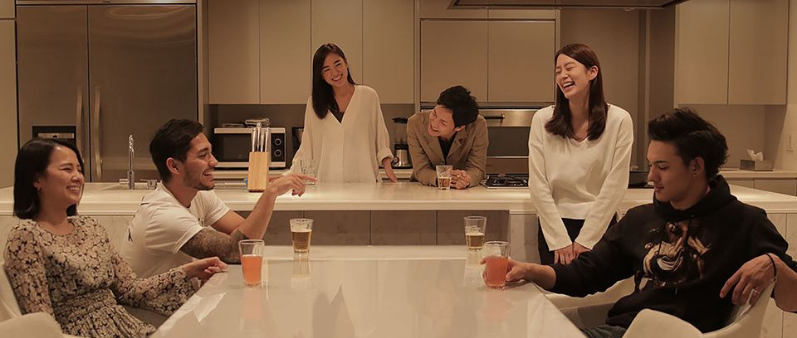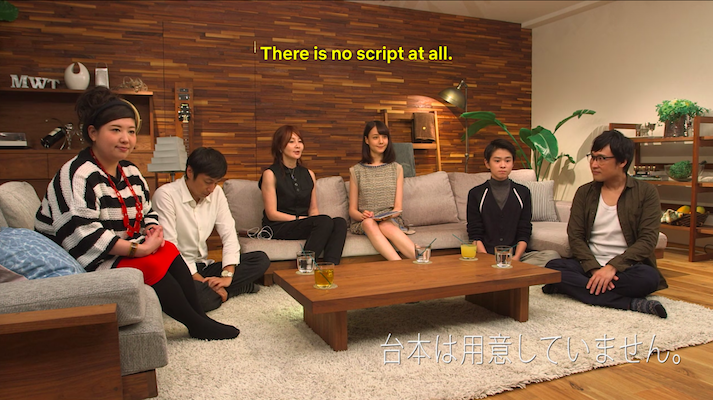
Learn Japanese with “Terrace House” – The Netflix Reality TV Cult Hit
Binge-Watch “Terrace House” and Speak Japanese!
Listening to “natural” Japanese is crucial if you want to become fluent in the language. Watching movies and TV dramas is a great place to start, but nothing beats reality TV shows.
It is hard to find Japanese reality shows in the US, but you can get an amazing one on Netflix called Terrace House.
What is Terrace House?
Terrace House is a hugely popular Japanese reality TV show originally released in 2012 and now in its 5th season. This latest season, titled “Terrace House: Tokyo 2019-2020” aired last spring in Japan and is scheduled to be released in the US on Netflix on September 10.
The premise of the show is similar to MTV’s “The Real World,” with 6 young strangers coming together in a beautiful house, negotiating relationships and daily living. The refreshingly charming and addictive “Terrace House” is as far from “The Real World,” however, as “The British Baking Show” is from “Hell’s Kitchen.”
Click the ‘CC’ icon on the video control bar for English subtitles
Since the cast is nearly all Japanese, you see stark cultural differences in terms of how people interact and build relationships.
One unique element in this show is the Terrace House panel commentators, a group of observers sitting in a studio watching the action along with us. Every 10 minutes they chime in with analysis and commentary, making you feel like you are viewing the show with friends.

How is Terrace House Good for Learning Japanese?
There are two main things that you can learn from this show:
- Casual, informal conversational Japanese language, and
- Understanding Japanese cultural differences.
Casual Japanese Conversations
1. Keigo to Casual Conversation
There are many levels of honorific speech in Japanese. Usually, people use keigo (the most polite and formal words and phrases) when they meet someone for the first time, but how do you know when to stop?
There is no clear rule for when to stop using keigo, especially when there is no senpai (先輩 senior) / kouhai (後輩 junior) relationship.
It is interesting to observe when the residents of Terrace House stop using keigo. In the beginning, you see them asking each other’s age to figure out how formally they should speak. But eventually, they quit using keigo because they all live in the same house without a hierarchical relationship.
2. Non-Textbook Casual Japanese
Conversational Japanese often doesn’t have a subject in the sentence.
For example:
Itsukara kareshi inai no? (いつから彼氏いないの?)
- Since when (you) don’t have a boyfriend?
Toshiue-zuki? (年上好き?)
- (Are you an) older-person-liker?
Kyo nanka aru? (今日なんかある?)
- Do (you) have anything today?
Kyo baito. (今日バイト。)
- (I have) part-time work today.
They don’t say anything equivalent to “you” or “I” when who they are talking about is obvious. Listening to their conversations will help you understand this concept.
However, keep in mind that this is not always “correct” Japanese. It is just a natural way of speaking within the kind of informal relationships in this show.
3. Pronunciation
Native Japanese speakers tend not to move their mouths much when speaking. However, when you watch scripted programs, the actors speak more clearly than in a natural conversation so the audience can better understand.
Since Terrace House is an unscripted reality show, the residents (who are not actors) don’t try to speak clearly for us. This may make it difficult for you to catch what they are saying, but it is a good practice to listen to the real/natural pronunciation and cadence of the language.
Cultural Differences
1. Japanese Millennials
Observe how Japanese millennials think and behave, compared to millennials in your own country.
The cast members talk not only about their love lives but also about their careers, dreams, family relationships and so on.
Do the Terrace House members speak or think similarly to people in your country? You may feel that some of them are immature, but others behave like smart, thoughtful adults. Noticing how these individuals think will help deepen your understanding of Japanese culture.
2. Discussing Physical Appearances
It may not be a good thing, but young Japanese women are particularly sensitive about their appearance, and will often mention physical attributes in a compliment.
Many of the Terrace House cast members are models, so they, especially, talk about physical appearance:
kao chicchai ne! (顔ちっちゃいね!– Your face is small! )
me ga ookii ne! (目が大きいね!– Your eyes are big! )
3. Confession Before Anything
Love relationships start naturally in reality shows featuring single, young adults. But in Japan (or at least in Terrace House) they do not start without a kokuhaku (告白 confession).
Two individuals will invariably wonder and worry about their relationship if there is no kokuhaku from either of them.
The term “going steady” seems old-fashioned today and isn’t heard much in the West anymore, but the equivalent word tsukiau (付き合う) is still commonly used in Japanese culture.
Finally… It’s a Comedy Too!
Advanced level viewers can try watching Yama Channel on YouTube. Ryota Yamasato, aka Yama-chan, is one of the panel commentators on Terrace House and is also a very popular comedian. He always gives his opinion with no filter, making this show very entertaining.
Yama Channel doesn’t have subtitles, unfortunately, but listening to Yama-chan’s dokuzetsu (毒舌 evil tongue) in a good tempo is like listening to a comedy genre called mandan (慢談 stand-up comedy), so many Japanese viewers eagerly anticipate the latest Yama-channel after each episode of “Terrace House.”
If you have never seen Terrace House, start with the first season “Boys & Girls in the City” which was shot in Tokyo. By the time you finish, hopefully, the 5th season (which is in Tokyo again!) will be released in the US.
Jump Start Your Japanese With the Pimsleur App!
Want to get beyond the subtitles? Try the Full Pimsleur Japanese Premium Course for 7 days Free. Only $19.95/month thereafter. New low subscription price!
No Comments for "Learn Japanese with “Terrace House” – The Netflix Reality TV Cult Hit"